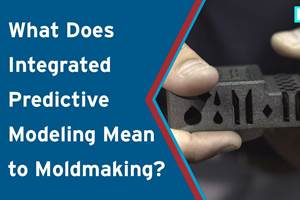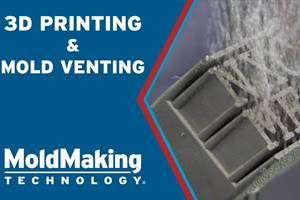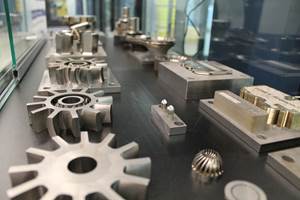Understanding the Relationship Between the Hot Runner and the Mold
Failing to understand and meet key mold design aspects - such as the importance of adequate structural back up between the cavity inserts, the mold plates and the hot runner system components - could compromise overall mold performance.
There are three main components to the injection molding process: the injection molding machine, the mold and the molding resin (or material). Most often, water temperature controllers, part handling systems and other peripheral equipment referred to as auxiliaries are considered to play more of a supportive role.
Of the three major components, the widest variation is in the mold. Each part design demands a different size, shape and configuration of the mold. Molds also are widely varied as far as options for melt delivery (runner systems). Yet it seems common that the mold be referred to as an entity regardless of type, configuration or design related to the melt delivery system. As such, we might refer to a three-plate cold runner or a valve-gated hot runner in the same way. To the plastics processor, it is all part of the "unit" to be placed between the machine platens.
For processors, this can be a benefit or a liability, depending upon their relationship with the mold supplier and their level of understanding the technology that went into the design and construction of the mold. As there are few full-service moldmaking companies in the world, mold suppliers usually use other suppliers for the mold base, the hot runner system and sometimes even the molding impressions (cores and cavities). This supplier diversity can lead to longer-than-normal troubleshooting and mold debugging, especially if there are supplier performance issues to be investigated.
The mold is the heart of the molding system. Its specifications and intended function must be fully understood. Getting to know all of the potential suppliers and understanding their respective products, experience, fields of expertise, etc. is time consuming and becoming more so. As a consequence, more processors are choosing to select mold suppliers having a broad experience base and who are capable of single source responsibility for the design and manufacture of all mold components.
What You Need to Know
Failing to understand and meet key mold design aspects such as adequate structural back up between the cavity inserts, the mold plates and the hot runner system components could compromise overall mold performance. For example, if the mold is deflected through lack of proper support, this could lead to a less-than-perfect product - flashing might occur, for instance. These are all important criteria in comprehending the relationship between the mold and the hot runner system.
A high degree of mold technology and a comprehensive understanding of the interaction of all constituents that comprise the mold is another key to successful moldmaking, in addition to experience with building a wide range of molds - including high cavitation molds (many with complex movements), stack molds, unwind molds, multi-color/ multi-material molds and insert molds. Having the ability to offer your mold technology, hot runner knowledge and flow analysis expertise to the other moldmakers helps to attain a win-win-win situation for them, their customers and your shop.
Minimizing downtime increases mold productivity. You can address this by incorporating design criteria focused on in-press maintenance. All hot runner components, including nozzle tips and nozzle heaters, should be accessible for repair or replacement in the injection molding machine. Even the piston and valve stem assemblies of valve-gated systems should be accessible in the press without the need for removing any plates or even screws from the mold base. All of these features may contribute to productivity by eliminating the need to remove the mold from the machine and quickly getting back into production.
Understanding the mold is a necessity. Understanding the relationship between the mold and its key components - particularly the hot runner system - is essential to part quality, optimum cycle time, mold longevity and minimum maintenance. Injection molding continues to become more sophisticated and automated, and without a balanced and optimized mold, as a complete unit, the molded part quality and molding system performance could be in jeopardy.
Related Content
VIDEO: What Does Integrated Predictive Modeling Mean to Moldmaking
Although conformal cooling is not a new concept, new technologies have made it a very hot topic, including predictive engineering models and 3D printing. Learn about a new conformal cooling process and algorithm and what it reveals about hot spots and conformal cooling design.
Read MoreVIDEO: How can 3D Printed Tooling Improve Injection Mold Venting?
Proper venting is one of a mold builders toughest challenges as molders struggle to keep vents free flowing in production. Learn how to apply 3D printing to mold venting and the benefits of additive venting inserts.
Read MoreHow to Use Thermal Management to Improve Mold Cooling
A review of common mold cooling issues and possible solutions, including 3D printing applications.
Read MoreLights-Out Metal 3D Printer Minimizes EDM Needs for Moldmakers
The Matsuura LUMEX series boasts both forming and milling capabilities in one unit, achieving highly accurate mold component production, with the ablity to integrate conformal cooling and porous venting.
Read MoreRead Next
Are You a Moldmaker Considering 3D Printing? Consider the 3D Printing Workshop at NPE2024
Presentations will cover 3D printing for mold tooling, material innovation, product development, bridge production and full-scale, high-volume additive manufacturing.
Read MoreHow to Use Continuing Education to Remain Competitive in Moldmaking
Continued training helps moldmakers make tooling decisions and properly use the latest cutting tool to efficiently machine high-quality molds.
Read MoreHow to Use Strategic Planning Tools, Data to Manage the Human Side of Business
Q&A with Marion Wells, MMT EAB member and founder of Human Asset Management.
Read More














.jpg;maxWidth=300;quality=90)










